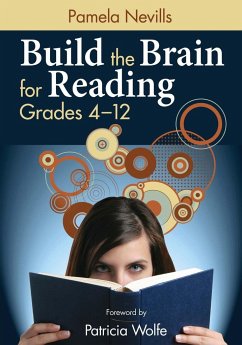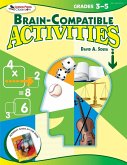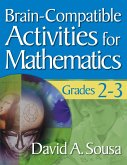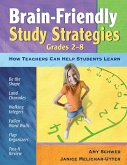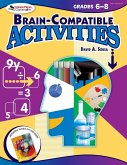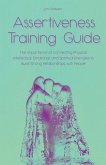Pamela Nevills
Build the Brain for Reading, Grades 4-12
Pamela Nevills
Build the Brain for Reading, Grades 4-12
- Broschiertes Buch
- Merkliste
- Auf die Merkliste
- Bewerten Bewerten
- Teilen
- Produkt teilen
- Produkterinnerung
- Produkterinnerung
Engage students' brains with state-of-the-art literacy strategies. This reference infuses the most current neurology research into concrete steps for targeted, developmentally appropriate reading instruction.
Andere Kunden interessierten sich auch für
![Brain-Compatible Activities, Grades 3-5 Brain-Compatible Activities, Grades 3-5]() David A. SousaBrain-Compatible Activities, Grades 3-519,99 €
David A. SousaBrain-Compatible Activities, Grades 3-519,99 €![Brain-Compatible Activities for Mathematics, Grades 2-3 Brain-Compatible Activities for Mathematics, Grades 2-3]() David A. SousaBrain-Compatible Activities for Mathematics, Grades 2-323,99 €
David A. SousaBrain-Compatible Activities for Mathematics, Grades 2-323,99 €![Brain-Friendly Study Strategies, Grades 2-8 Brain-Friendly Study Strategies, Grades 2-8]() Amy SchwedBrain-Friendly Study Strategies, Grades 2-838,99 €
Amy SchwedBrain-Friendly Study Strategies, Grades 2-838,99 €![Brain-Compatible Activities, Grades 6-8 Brain-Compatible Activities, Grades 6-8]() David A. SousaBrain-Compatible Activities, Grades 6-819,99 €
David A. SousaBrain-Compatible Activities, Grades 6-819,99 €![Except the Lord Build the House: A Biblical Examination of the Return of Jesus Christ and the Rapture of His Church Except the Lord Build the House: A Biblical Examination of the Return of Jesus Christ and the Rapture of His Church]() Norman EberlyExcept the Lord Build the House: A Biblical Examination of the Return of Jesus Christ and the Rapture of His Church22,99 €
Norman EberlyExcept the Lord Build the House: A Biblical Examination of the Return of Jesus Christ and the Rapture of His Church22,99 €![The Art of Enough, Creativity, Compassion, and Decisions That Build a Better World The Art of Enough, Creativity, Compassion, and Decisions That Build a Better World]() Emmanuel JosephThe Art of Enough, Creativity, Compassion, and Decisions That Build a Better World26,99 €
Emmanuel JosephThe Art of Enough, Creativity, Compassion, and Decisions That Build a Better World26,99 €![Assertiveness Training Guide The Importance of Connecting Physical, Intellectual, Emotional, and Spiritual Energies to Build Strong Relationships with People Assertiveness Training Guide The Importance of Connecting Physical, Intellectual, Emotional, and Spiritual Energies to Build Strong Relationships with People]() Jim ColajutaAssertiveness Training Guide The Importance of Connecting Physical, Intellectual, Emotional, and Spiritual Energies to Build Strong Relationships with People11,99 €
Jim ColajutaAssertiveness Training Guide The Importance of Connecting Physical, Intellectual, Emotional, and Spiritual Energies to Build Strong Relationships with People11,99 €-
-
-
Engage students' brains with state-of-the-art literacy strategies. This reference infuses the most current neurology research into concrete steps for targeted, developmentally appropriate reading instruction.
Produktdetails
- Produktdetails
- Verlag: Corwin
- Seitenzahl: 202
- Erscheinungstermin: 18. Oktober 2010
- Englisch
- Abmessung: 254mm x 178mm x 11mm
- Gewicht: 391g
- ISBN-13: 9781412961110
- ISBN-10: 1412961114
- Artikelnr.: 31257478
- Herstellerkennzeichnung
- Libri GmbH
- Europaallee 1
- 36244 Bad Hersfeld
- gpsr@libri.de
- Verlag: Corwin
- Seitenzahl: 202
- Erscheinungstermin: 18. Oktober 2010
- Englisch
- Abmessung: 254mm x 178mm x 11mm
- Gewicht: 391g
- ISBN-13: 9781412961110
- ISBN-10: 1412961114
- Artikelnr.: 31257478
- Herstellerkennzeichnung
- Libri GmbH
- Europaallee 1
- 36244 Bad Hersfeld
- gpsr@libri.de
Pamela Nevills is first and foremost a teacher of children and adults. Her passion for teaching includes a full range of educator experiences from teaching in the primary grades, to teaching middle and high school, to being a teacher supervisor and instructor in university undergraduate, graduate, and doctoral programs. She participates in local, state, and national educational committees in the area of special education. As a two-time member of the instructional textbook selection committee for reading in the state of California, she brings expert knowledge of how children learn to read, and the materials teachers can use to follow the science of reading. Her passion for the cognitive and neurological aspects of reading stems from interactions with Dr. Pat Wolfe. Nevills is a national and international speaker and consultant on topics that include reading standards according to the Common Core; brain development from infancy to adulthood; all aspects of cognitive, neurological involvement for reading; and school management and design for teaching reading. Writing became a part of Nevills's work as she published for newsletters, the state of California, the Journal of Staff Development, and Corwin. Her involvement also includes research and studies for church organizations and an advisory board position for preschool. To contact Pamela Nevills, please email panevills@earthlink.net..
Acknowledgments
About the Author
1. Learning from Childhood to Adulthood
2. Brain Structures Accessed for Reading
3. Learning and Neuron Activity
4. Memory Systems and Learning
5. Reading with Comprehension, Automaticity, and Fluency
6. Motivation and Ability to Learn through the Grades: How different is an
adolescent's brain?
7. Neurology and Technology for All Aspects of the Curriculum
8. Older Students Who Struggle with Reading to Learn
9. Neurology for all Content Areas
10. Resources, Connections, and Future Classrooms
References
Further Reading
Glossary
Index
About the Author
1. Learning from Childhood to Adulthood
2. Brain Structures Accessed for Reading
3. Learning and Neuron Activity
4. Memory Systems and Learning
5. Reading with Comprehension, Automaticity, and Fluency
6. Motivation and Ability to Learn through the Grades: How different is an
adolescent's brain?
7. Neurology and Technology for All Aspects of the Curriculum
8. Older Students Who Struggle with Reading to Learn
9. Neurology for all Content Areas
10. Resources, Connections, and Future Classrooms
References
Further Reading
Glossary
Index
Acknowledgments
About the Author
1. Learning from Childhood to Adulthood
2. Brain Structures Accessed for Reading
3. Learning and Neuron Activity
4. Memory Systems and Learning
5. Reading with Comprehension, Automaticity, and Fluency
6. Motivation and Ability to Learn through the Grades: How different is an
adolescent's brain?
7. Neurology and Technology for All Aspects of the Curriculum
8. Older Students Who Struggle with Reading to Learn
9. Neurology for all Content Areas
10. Resources, Connections, and Future Classrooms
References
Further Reading
Glossary
Index
About the Author
1. Learning from Childhood to Adulthood
2. Brain Structures Accessed for Reading
3. Learning and Neuron Activity
4. Memory Systems and Learning
5. Reading with Comprehension, Automaticity, and Fluency
6. Motivation and Ability to Learn through the Grades: How different is an
adolescent's brain?
7. Neurology and Technology for All Aspects of the Curriculum
8. Older Students Who Struggle with Reading to Learn
9. Neurology for all Content Areas
10. Resources, Connections, and Future Classrooms
References
Further Reading
Glossary
Index

